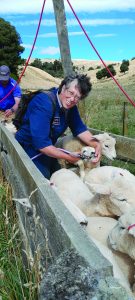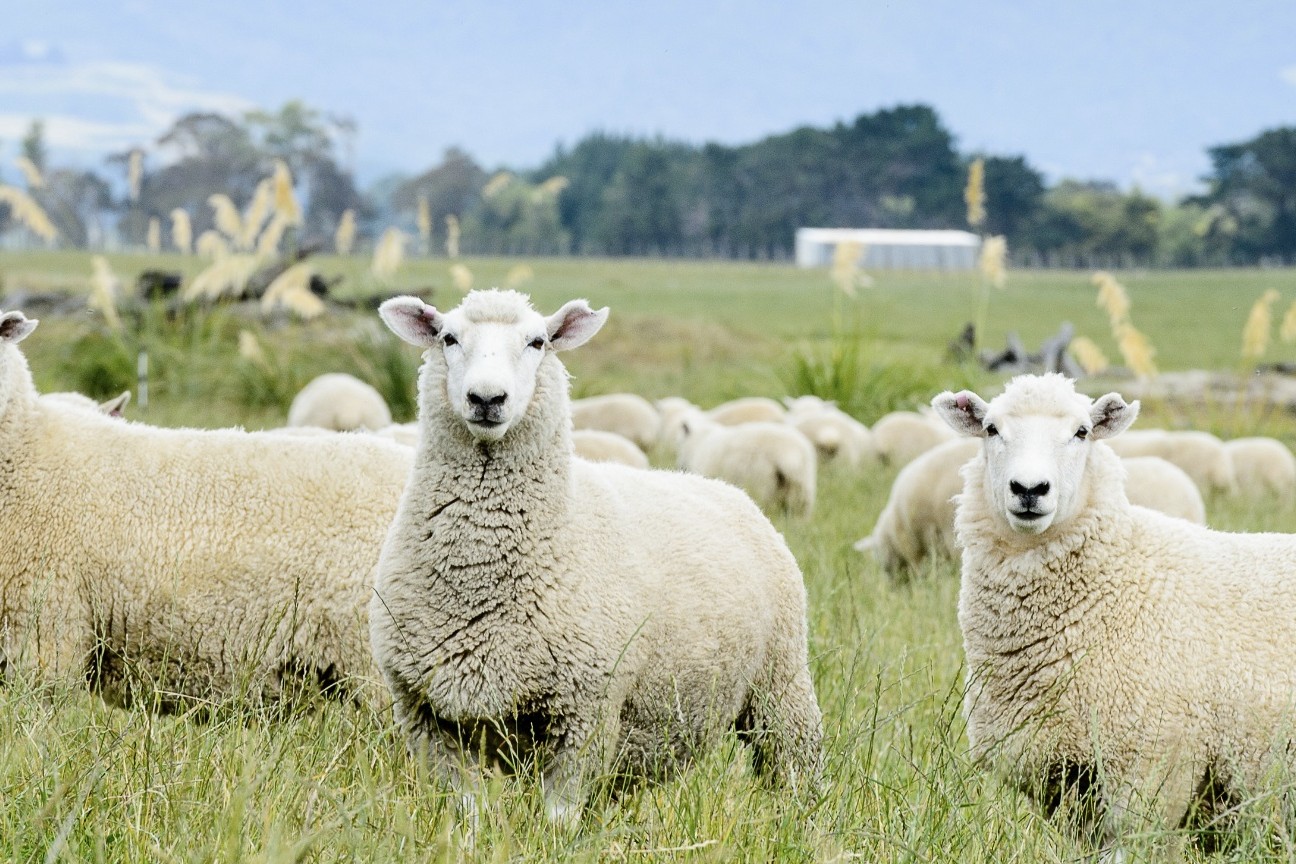Facing up to the threat
As an increasing number of sheep farmers grapple with triple drench resistance, a group of Wairarapa farmers are meeting on a regular basis to learn about managing parasites without relying on drenches. Words Sandra Taylor.

Formed at the end of 2022 and funded by Beef + Lamb New Zealand (B+LNZ), the Livestock Parasite Management Group (LPMG) is made up of 12 sheep and beef farmers, all looking at ways to protect their businesses from a drench resistance challenge.
The group, which is facilitated by vet Sara Sutherland from The Vet Clinic Wairarapa, meets around four times a year, giving members the opportunity to share their experiences of management changes they have made since joining the group and to learn from subject matter experts.
The LPMG is being evaluated by research firm Scarlatti to understand what impact being part of the group is having on members. Only one year into the group’s formation, Scarlatti found that farmers had already begun making positive and informed changes to their parasite management and are putting strategies in place to combat drench resistance. The most common changes made were in grazing management, extended drench intervals and an increase in the monitoring of Faecal Egg Counts (FEC).
The value of small group learning
The Scarlatti report highlighted just how beneficial farmers found the group’s farmer-to-farmer approach. Group members reported that they most enjoyed the opportunities to collaborate and share information with other farmers. Due to the success of the Wairarapa group B+LNZ is establishing seven other Livestock Parasite Management Groups nationwide to support farmers as they make changes to the way they manage parasites in the face of drench resistance.
Changing mindsets
Sutherland says the biggest change she has seen amongst the group’s members is in their mindset. Farmers realise they can’t drench their way out of a parasite problem and are looking at strategies such as changing their farm system to reduce the number of days lambs are onfarm.
The group includes a mix of commercial breeders and more intensive finishing operations and each farmer brings his or her own perspective and management tools to the group. “They are all learning from each other,” she says.

Sutherland, who is a Wormwise facilitator, says she started the group to give farmers the opportunity to delve deeper into the very complex world of internal parasite management and share their experiences.
While some farmers have made quite dramatic changes to their farm systems, others are making more minor adjustments. “The tools used will be different on each farm, but most importantly, farmers need to understand the impact these tools are having on their farm system. It’s about understanding the variables.”
She says she has been pleasantly surprised at the level of engagement amongst the group’s members and adds that they are a fun group to facilitate.
Putting theory in practice
On the 17,000-18,000 stock unit operation LPMG member Martin Reisima manages, they have changed their grazing management, increased drench intervals and their monitoring of FEC. Reisima says none of these changes have been drastic. Rather, they have simply focused on reducing their drench use and this has meant doing a lot more FEC and larval cultures to understand the species of parasites present. Management decisions are based on the results of these tests.
‘The biggest change I’ve seen amongst the group of farmers is in their mindset. They realise they can’t drench their way out of a parasite problem and are looking at strategies such as changing their farm system.’ – Sara Sutherland, The Vet Clinic Wairarapa
“For me, it’s been about a change in mindset away from just automatically drenching lambs every 28-30 days. Often you think they need a drench, but they don’t. It’s just a matter of doing a lot more monitoring.”
They are no longer routinely giving their lambs a pre-weaning drench and Reisima says FECs have not shown any worm burdens in these lambs, and neither have they noticed a drop in weaning weights. The time and money saved by not drenching 10,000 lambs pre-weaning has been significant.
When B+LNZ spoke to Reisima in July, they had been regularly monitoring FECs in their hoggets and these sheep had not been drenched since the middle of April. These were well grown 50kg-plus ewe replacements that, in the past, might have had at least two routine drenches in that time.
The farm has been growing more summer crops to help reduce the length of time lambs spend on grass and they have also been shutting off 80-100ha of their 1500ha effective farm from sheep for five to six months. “We are trying to avoid short rotations with young stock. We tried it last year and it worked well.” Lambs were run onto the rested pasture straight after weaning.
Autumn Trichostrongylus (Trichs) continue to be an issue exacerbated by the farm’s higher sheep to cattle ratio (70:30) and their trading stock.
They will strategically use a novel drench as a knock-out in autumn, but Reisima says timing is the key with a knock-out drench and they got the timing right with their ewe lambs this year. He says regular FECs might seem a hassle, but they can save significant amounts of time and money.
Similarly, it can take two weeks to get the results of larval cultures, but these can identify which worms are present so the most effective drench can be used. “We did a culture test at weaning and there were no Trichs present, so we used a triple drench instead of Zolvix which was a big cost saving.”
The cost of system changes in response to drench resistance
At a LPMG meeting late last year farm consultant Ed Harrison from Baker and Associates led the farmers through a modelling exercise looking at the cost of drench resistance and the financial ramifications of any farm system changes on a case study 1890ha hill country farm.
Harrison told farmers that drench resistance can have a massive impact. Reduced lamb growth in the face of resistant worms means lambs stay on the farm longer, more drench is used and more feed is needed leading to higher costs, further escalation of the existing drench resistance problem and animal welfare issues.
Even in a low-to-moderate drench resistance scenario, based on a 2012 AgResearch study, average lamb growth rates can drop from 110 to 60 grams/day and ewes lose condition as feed is partitioned into slow-growing lambs. As a result, scanning percentages fall away, lactation declines along with pre-weaning lamb growth rates and lambs are retained for longer to achieve saleable weights. Resistance problems compound in a challenging year, says Harrison, and costs increase because more stock is carried for longer.
He says it is important that any farm system changes can be practically implemented, that they suit the farm team and don’t have any unintended consequences, for example increased GHG emissions. At a potential starting cost of $96,390 per annum, left unaddressed drench resistance could ultimately threaten the future viability of the case-study hill country sheep and beef operation. From a baseline total gross margin (gross income minus variable costs) of $1,186,920, Harrison calculated that drench resistance at the lower end (drench efficacy 70-90%)
could cost the business $96,390 annually, reducing the business’s gross margin to $1,090,530.
If drench efficacy were to fall below 70%, then production losses would increase further and financial losses increase exponentially.
The case study farm is typical of many sheep and beef farms throughout the country where the management team is proactively working to prevent drench resistance becoming a production-limiting issue.

System change scenarios
Harrison ran through five system-change scenarios, all modelled using Farmax, which could be considered as the case-study farmers work to reduce their reliance on drench but maintain profitability.
These scenarios were; reducing ewe numbers, running a store lamb policy, selling in-lamb ewes, increasing their cattle ratio and only using terminal sires (buying in two-tooth replacements). These scenarios could potentially be used in combination.
Assess the cost of farm system changes
From a base Total Gross Margin of $1,186,920, Harrison calculated the variances from this baseline of the five scenarios. Reducing ewe numbers by 1000 generated an additional $71,820, a store lamb policy would cost the business $39,690, while selling scanned in-lamb ewes would reduce the total gross margin by $15,120.
Increasing the cattle ratio by 6%, from 27 to 33%, would add $77,490 to the bottom line and a terminal sire policy would, in theory, add $66,150 to the Total Gross Margin.
Reducing ewe numbers
In the reducing ewe number scenario, fewer ewes would mean more available feed, and ewes would therefore be in better condition and more resilient to internal parasites.
Ewes would be heavier at mating, increasing scanning percentages, and if that condition were to be maintained through winter on the extra feed available, they would produce more milk which would drive lamb survivability and pre-weaning growth rates.
Heavier lambs at weaning would mean more lambs sold at the weaning draft. Cull ewe weights would also be higher.
In this scenario, extra feed could be partitioned into ewe lambs, allowing hoggets to be mated.
Harrison admits it does require both a change of mindset and confidence to reduce ewe numbers. In this scenario, there is a reliance on achieving an increased percentage of lambs that are marketable at weaning.
Increasing cattle numbers
To maintain pasture quality, increasing the cattle numbers would complement the reduced ewe number scenario. Cow numbers would increase from 400 to 500 (including heifers) with a significant (1050) drop in ewe numbers.
This scenario would see ewe performance improve due to more feed being available. This would result in increased weaning weights, higher scanning percentages and reduced wastage with more lambs sold at the weaning draft.
Terminal policy
Using terminal sires over the entire ewe flock would increase weaning weights by 2-3kgs, so more lambs would be sold at weaning. This would reduce pasture contamination by parasites. Fewer lambs would also mean the ewes would be better fed over summer which would increase scanning percentages, lambing percentages and weaning weights. The challenge with this scenario is sourcing the 2,700 two-tooths replacements required every year to maintain ewe numbers at 9,700. It is therefore the least practical of the five options modelled. The critical factor in all these scenarios was weaning weights. Increasing weaning weights and the number of lambs sold at the weaning draft provides options. “On a farm with drench resistance, however you get the best weaning weights is
the way to go,” says Harrison. “This means less lamb days onfarm, therefore less contamination of pasture with resistant parasites.”
Reisima has found the Livestock Parasite Management Group to be very valuable. “Drench resistance is an issue everyone is faced with. We’ve got great farmers; everyone is open and transparent.”
He says while the Wairarapa is known for having high sheep ratios for the North Island, each of the Group’s members has a different farm system, and everyone can share their experiences of managing to reduce their reliance on drench.
While the property Reisima manages does have 1000 ha of cultivable land, some of the members farm hill country so their systems and experiences will be different.




